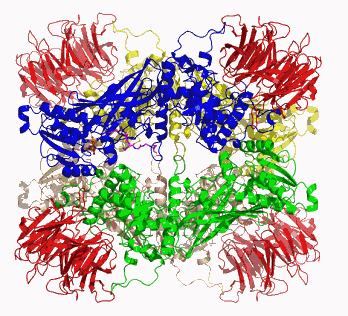Transmitting from one generation to the next the genetic message encoded in DNA is a well-understood concept in biology. There is now increasing awareness that chemical modifications of DNA and associated proteins are also transmitted across generations, and these changes are critical in determining the way the genetic message is read. Detailed understanding of the structures of the proteins that effect these changes is therefore highly coveted information. Thanks to the efforts of a research team from Eli Lilly and Company, with the help of the Lilly Research Laboratories Collaborative Access Team (LRL-CAT) beamline 31-ID at the U.S. Department of Energy Office of Science’s Advanced Photon Source, the structure of an important methylation enzyme is now known. The results of this research can be utilized to provide new direction and focus in the race to create drugs to combat disease, especially cancer.
A prime example of chemical modifications is the addition of a methyl group (methylation) to the side-chain of arginine residues of proteins, dramatically altering their activity and interactions. Aberrant methylation has been linked to a wide variety of diseases, most notably cancer.
The Lilly research team investigated a protein from a group of enzymes known as protein arginine methyltransferases (PRMTs), which play important roles in cell signaling, gene regulation, and the transport of proteins and nucleic acids.
The team focused on PRMT5, which had been previously shown to be part of a complex of partner proteins that help regulate its function and specificity. Because enhanced levels of PRMT5 have been observed in various types of cancer, it is a focus of anti-cancer drug research.
In particular, the researchers were interested in how PRMT5 interacts with methylosome protein 50 (MEP50), known to be a critical mediator of binding with other members of the protein complex and with substrates. Phosphorylation of either MEP50 or of PRMT5 itself can control methyltransferase activity of PRMT5. Activation of the methyltransferase activity of PRMT5 was known to prolong survival of tumor cells while mutants that disrupt its association with MEP50 inhibited that methyltransferase activity.
Since MEP50 activity has been linked especially to ovarian and prostate cancer, details of its structure and modes of interaction with PRMT5 and other members of the binding complex are prime targets of current research.
The research team determined a definitive structure for PRMT5 in interaction with MEP50, bound to a peptide derived from histone H4. The team combined data from chromatography, sedimentation analysis, enzymology, and x-ray crystallography using data collected at 31-ID to elucidate the structure and activity of the PRMT5:MEP50 complex.
The resulting structure yielded a surprise: a hetero-octameric complex that shows close interaction between a seven-bladed propeller-like MEP50 and the N-terminal domain of PRMT5. The structure offers a clear view of how substrate recognition occurs and points the way toward promising targets for drug design.
The researchers were able to compare their data from human PRMT5 with newly published data on PRMT5 from the nematode worm, which shows 31% sequence identity with human PRMT5. The dimeric PRMT5 complex in the nematode was strikingly different than the large octameric human PRMT5, in which four molecules of PRMT5 and four of MEP50 form the functional core of the PRMT5 complexes.
This important octameric structural core in human PRMT5 is proposed as the main driver of interactions with partner proteins to create a multimeric complex of subunits with different specificities and functions. In addition, when compared with what was previously known about PRMTs, important differences in the three-dimensional structure of PRMT5 and how it interacts with MEP50 were discovered.
Such critical details will be all-important in anti-cancer drug design. The structural data also allow the role of MEP50 to be expanded by suggesting its importance in recruiting substrates and partners to PRMT5.
By providing a detailed structure of PRMT5 in interaction with MEP50, the research team has revealed critical insights about posttranslational methylation and identified promising target sites for drugs to combat cancer and other diseases related to methylation processes. — Mona Mort
See: Stephen Antonysamy*, Zahid Bonday, Robert M. Campbell, Brandon Doyle, Zhanna Druzina, Tarun Gheyi, Bomie Han, Louis N. Jungheim, Yuewei Qian, Charles Rauch, Marijane Russell, J. Michael Sauder, Stephen R. Wasserman, Kenneth Weichert, Francis S. Willard, Aiping Zhang, and Spencer Emtage**, “Crystal structure of the human PRMT5:MEP50 complex,” Proc. Natl. Acad. Sci. USA 109(44), 17960 (October 30, 2012). DOI:10.1073/pnas.1209814109
Author affiliation: Eli Lilly and Company
Correspondence: *[email protected], **[email protected]
LRL-CAT is operated by Eli Lilly & Company Use of the Advanced Photon Source at Argonne National Laboratory was supported by the U.S. Department of Energy’s Office of Science under Contract No. DE-AC02-06CH11357.
The Advanced Photon Source at Argonne National Laboratory is one of five national synchrotron radiation light sources supported by the U.S. Department of Energy’s Office of Science to carry out applied and basic research to understand, predict, and ultimately control matter and energy at the electronic, atomic, and molecular levels, provide the foundations for new energy technologies, and support DOE missions in energy, environment, and national security. To learn more about the Office of Science x-ray user facilities, visit http://science.energy.gov/user-facilities/basic-energy-sciences/.
Argonne National Laboratory seeks solutions to pressing national problems in science and technology. The nation's first national laboratory, Argonne conducts leading-edge basic and applied scientific research in virtually every scientific discipline. Argonne researchers work closely with researchers from hundreds of companies, universities, and federal, state and municipal agencies to help them solve their specific problems, advance America's scientific leadership and prepare the nation for a better future. With employees from more than 60 nations, Argonne is managed by UChicago Argonne, LLC for the U.S. Department of Energy's Office of Science.

